Solar eclipse of November 3, 1994
A total solar eclipse occurred on November 3, 1994. A solar eclipse occurs when the Moon passes between Earth and the Sun, thereby totally or partly obscuring the image of the Sun for a viewer on Earth. A total solar eclipse occurs when the Moon's apparent diameter is larger than the Sun's, blocking all direct sunlight, turning day into darkness. Totality occurs in a narrow path across Earth's surface, with the partial solar eclipse visible over a surrounding region thousands of kilometres wide. Totality was visible in Peru, northern Chile, Bolivia, northern Argentina, Paraguay including the northeastern part of its capital Asunción, Brazil and Gough Island of British overseas territory of Saint Helena, Ascension and Tristan da Cunha. The Iguazu Falls, one of the largest waterfalls systems in the world, also lies in the path of totality. Totality lasted about 4.4 minutes, so it was a relatively long total solar eclipse. Occurring only 10 hours and 2 minutes before perigee (Perigee on November 3, 1994 at 23:41 UTC, while greatest eclipse at 13:39 UTC), the moon's apparent diameter was too larger.
| Solar eclipse of November 3, 1994 | |
|---|---|
.jpg.webp) Totality with diamond ring effect in Litoral Province, Bolivia | |
 Map | |
| Type of eclipse | |
| Nature | Total |
| Gamma | -0.3522 |
| Magnitude | 1.0535 |
| Maximum eclipse | |
| Duration | 263 sec (4 m 23 s) |
| Coordinates | 35.4°S 34.2°W |
| Max. width of band | 189 km (117 mi) |
| Times (UTC) | |
| Greatest eclipse | 13:40:06 |
| References | |
| Saros | 133 (44 of 72) |
| Catalog # (SE5000) | 9496 |
Images

More details about the Total Solar Eclipse of 1994 November 3.
Eclipse Magnitude: 1.05351
Eclipse Obscuration: 1.10989
Gamma: -0.35216
Greatest Eclipse: 1994 November 03 at 13:39:05.4 UTC
Location of Greatest Eclipse: 35º21'22" S, 34º13'21" W, South Atlantic Ocean, 1,586 km (985.5 mi) off the coast of Brazil
Duration of Totality: 4 minutes, 23.28 seconds (263.28 seconds)
Sun Right Ascension: 14.57
Sun Declination: -15.1
Sun Diameter: 1934.8 arc-seconds
Moon Right Ascension: 14.56
Moon Declination: -15.4
Moon Diameter: 2006.0 arc-seconds
Saros Series: 133rd (44 of 72)
Related eclipses
Eclipses of 1994
Solar eclipses 1993–1996
This eclipse is a member of a semester series. An eclipse in a semester series of solar eclipses repeats approximately every 177 days and 4 hours (a semester) at alternating nodes of the Moon's orbit.[1]
| Solar eclipse series sets from 1993–1996 | ||||||
|---|---|---|---|---|---|---|
| Descending node | Ascending node | |||||
| Saros | Map | Gamma | Saros | Map | Gamma | |
| 118 | 1993 May 21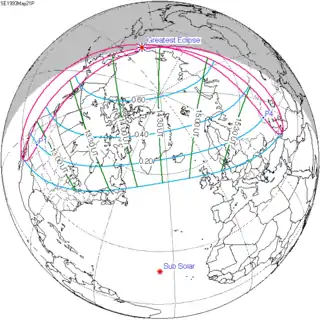 Partial | 1.13720 | 123 | 1993 November 13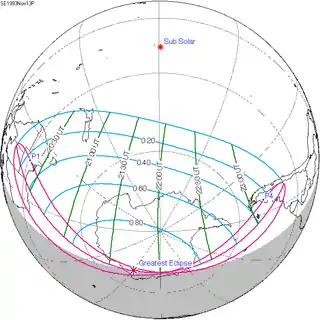 Partial | -1.04114 | |
| 128 | 1994 May 10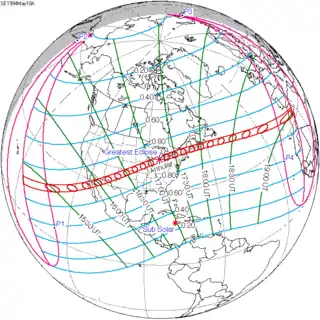 Annular | 0.40771 | 133.jpg.webp) Totality at Bolivia | 1994 November 3 Total | -0.35216 | |
| 138 | 1995 April 29 Annular | -0.33821 | 143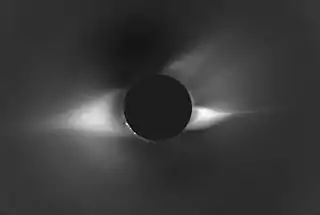 Totality at Dundlod, India | 1995 October 24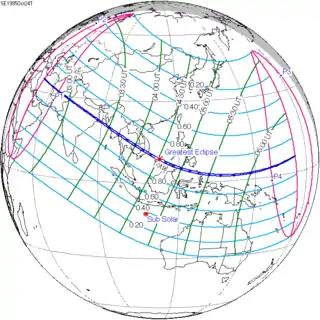 Total | 0.35176 | |
| 148 | 1996 April 17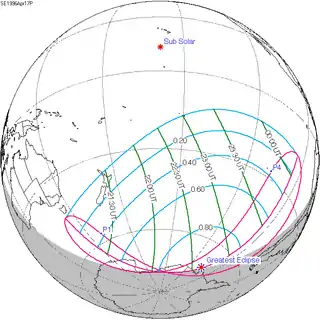 Partial | -1.05796 | 153 | 1996 October 12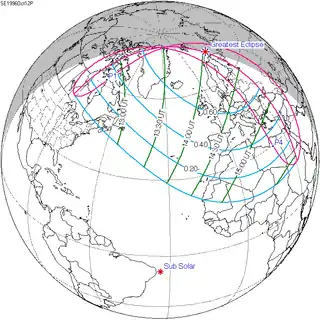 Partial | 1.12265 | |
Saros 133
Solar Saros 133, repeating every 18 years, 11 days, contains 72 events. The series started with a partial solar eclipse on July 13, 1219. It contains annular eclipses from November 20, 1435, through January 13, 1526, with a hybrid eclipse on January 24, 1544. It has total eclipses from February 3, 1562, through June 21, 2373. The series ends at member 72 as a partial eclipse on September 5, 2499. The longest duration of totality was 6 minutes, 49.97 seconds on August 7, 1850.[2] The total eclipses of this saros series are getting shorter and farther south with each iteration. All eclipses in this series occurs at the Moon’s ascending node.
| Series members 30–56 occur between 1742 and 2211 | ||
|---|---|---|
| 30 | 31 | 32 |
| June 3, 1742 | June 13, 1760 | 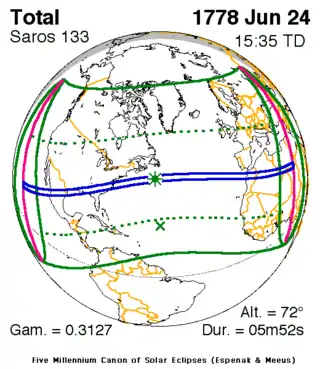 June 24, 1778 |
| 33 | 34 | 35 |
| July 4, 1796 | July 17, 1814 | July 27, 1832 |
| 36 | 37 | 38 |
| August 7, 1850 | 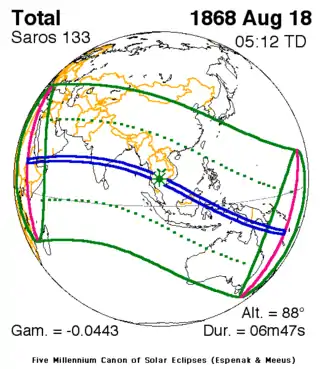 August 18, 1868 |
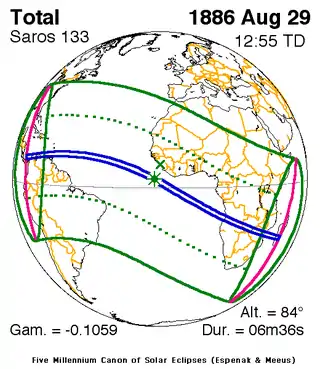 August 29, 1886 |
| 39 | 40 | 41 |
 September 9, 1904 |
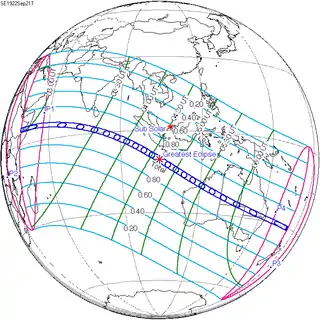 September 21, 1922 |
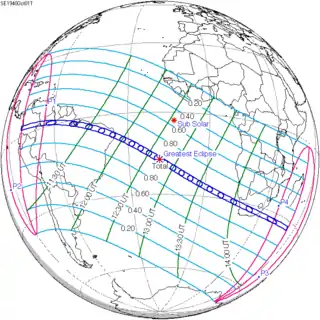 October 1, 1940 |
| 42 | 43 | 44 |
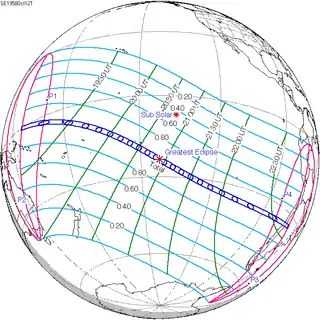 October 12, 1958 |
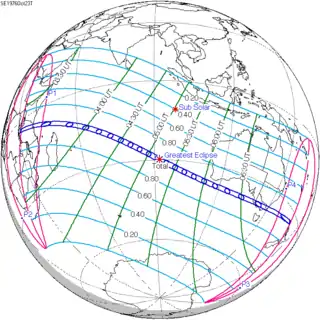 October 23, 1976 |
 November 3, 1994 |
| 45 | 46 | 47 |
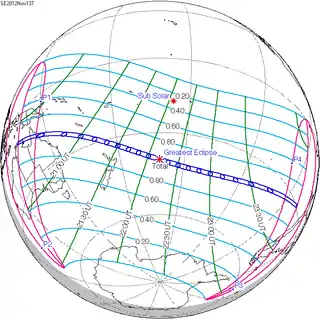 November 13, 2012 |
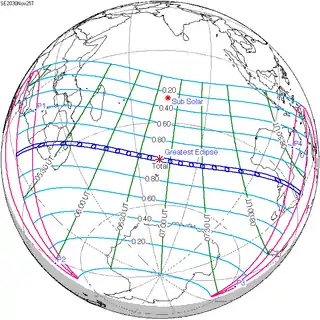 November 25, 2030 |
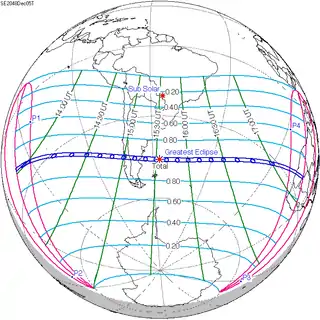 December 5, 2048 |
| 48 | 49 | 50 |
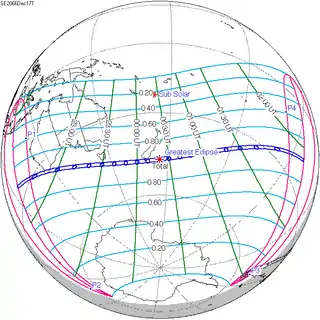 December 17, 2066 |
 December 27, 2084 |
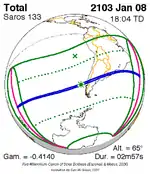 January 8, 2103 |
| 51 | 52 | 53 |
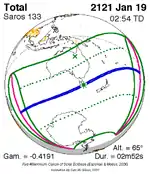 January 19, 2121 |
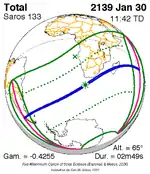 January 30, 2139 |
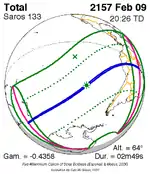 February 9, 2157 |
| 54 | 55 | 56 |
 February 21, 2175 |
 March 3, 2193 |
 March 15, 2211 |
Inex series
This eclipse is a part of the long period inex cycle, repeating at alternating nodes, every 358 synodic months (≈ 10,571.95 days, or 29 years minus 20 days). Their appearance and longitude are irregular due to a lack of synchronization with the anomalistic month (period of perigee). However, groupings of 3 inex cycles (≈ 87 years minus 2 months) comes close (≈ 1,151.02 anomalistic months), so eclipses are similar in these groupings.
| Inex series members between 1901 and 2100: | ||
|---|---|---|
 January 3, 1908 (Saros 130) |
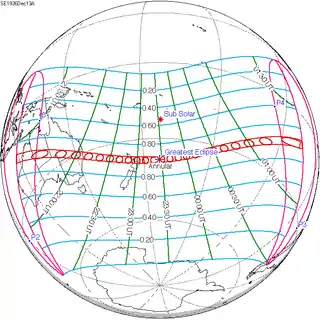 December 13, 1936 (Saros 131) |
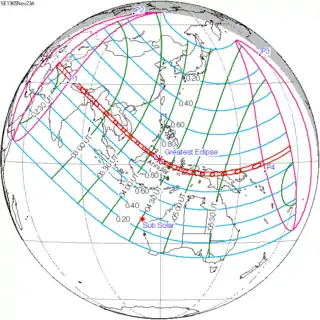 November 23, 1965 (Saros 132) |
 November 3, 1994 (Saros 133) |
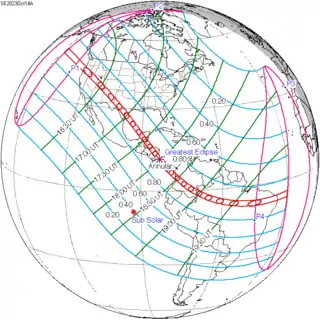 October 14, 2023 (Saros 134) |
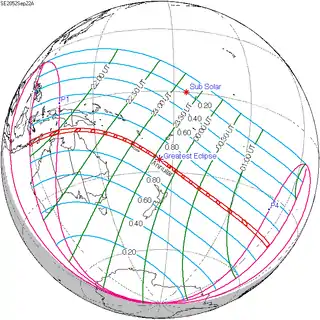 September 22, 2052 (Saros 135) |
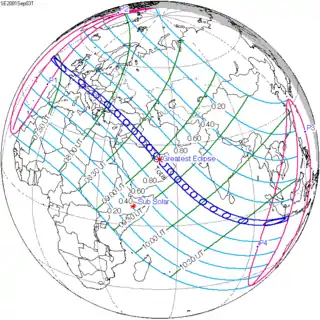 September 3, 2081 (Saros 136) |
||
Metonic series
The metonic series repeats eclipses every 19 years (6939.69 days), lasting about 5 cycles. Eclipses occur in nearly the same calendar date. In addition, the octon subseries repeats 1/5 of that or every 3.8 years (1387.94 days). All eclipses in this table occur at the Moon's ascending node.
| 21 eclipse events, progressing from south to north between June 10, 1964, and August 21, 2036 | ||||
|---|---|---|---|---|
| June 10–11 | March 27–29 | January 15–16 | November 3 | August 21–22 |
| 117 | 119 | 121 | 123 | 125 |
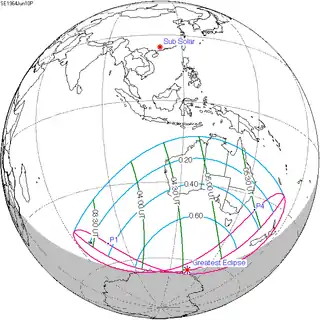 June 10, 1964 |
 March 28, 1968 |
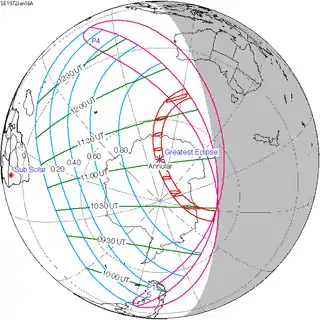 January 16, 1972 |
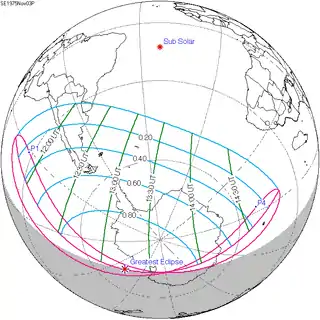 November 3, 1975 |
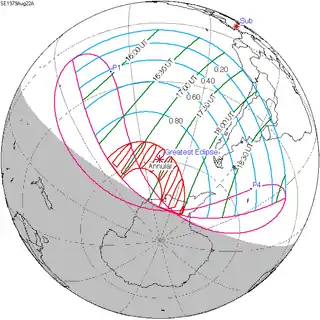 August 22, 1979 |
| 127 | 129 | 131 | 133 | 135 |
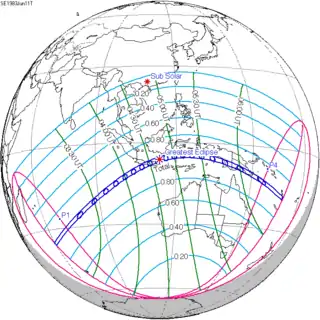 June 11, 1983 |
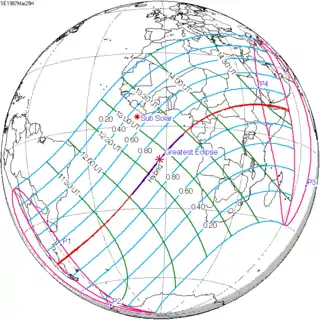 March 29, 1987 |
 January 15, 1991 |
 November 3, 1994 |
 August 22, 1998 |
| 137 | 139 | 141 | 143 | 145 |
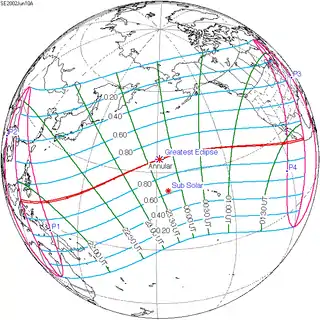 June 10, 2002 |
 March 29, 2006 |
 January 15, 2010 |
 November 3, 2013 |
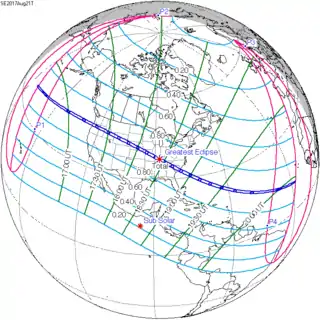 August 21, 2017 |
| 147 | 149 | 151 | 153 | 155 |
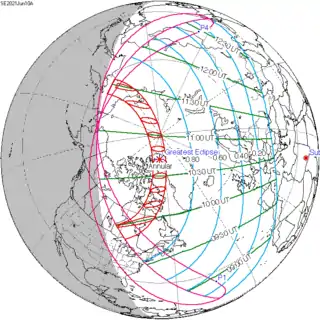 June 10, 2021 |
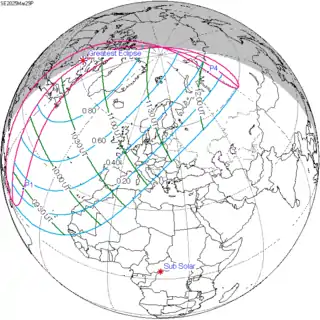 March 29, 2025 |
 January 14, 2029 |
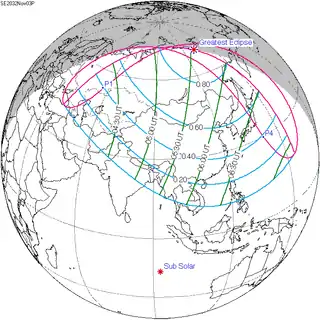 November 3, 2032 |
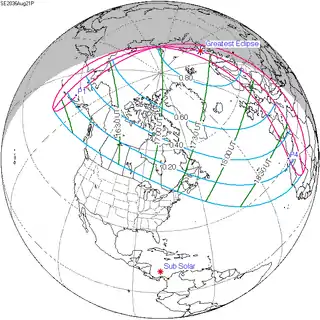 August 21, 2036 |
References
- van Gent, R.H. "Solar- and Lunar-Eclipse Predictions from Antiquity to the Present". A Catalogue of Eclipse Cycles. Utrecht University. Retrieved 6 October 2018.
- http://eclipse.gsfc.nasa.gov/SEsaros/SEsaros133.html
External links
- Earth visibility chart and eclipse statistics Eclipse Predictions by Fred Espenak, NASA/GSFC
Photos:
- Chile and Brazil, Prof. Druckmüller's eclipse photography site
- Bolivia, Prof. Druckmüller's eclipse photography site
- ON THE STRUCTURE OF 3.11.94 ECLIPSE CORONA
- Solar Corona Shape
- The 1994 Eclipse in Chile
| Wikimedia Commons has media related to Solar eclipse of 1994 November 3. |
.jpg.webp)

